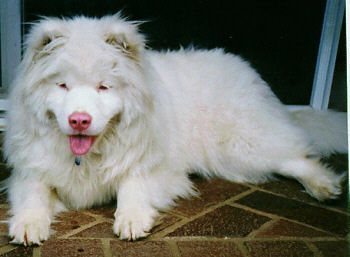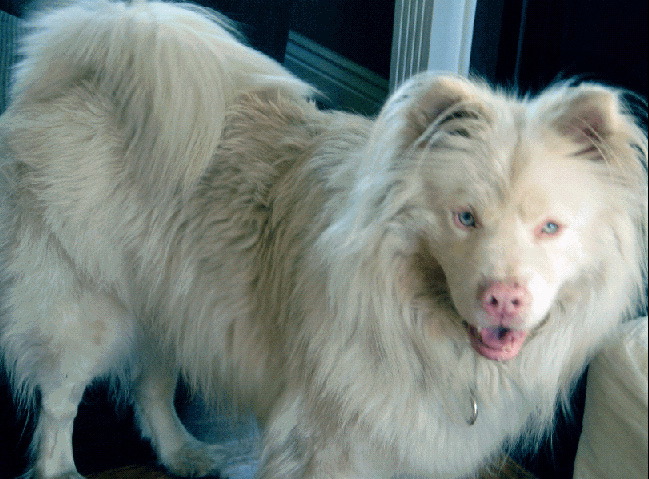Note: We do not currently have a health liaison for this disorder. If you would like to volunteer, please contact president@samoyedhealthfoundation.org and we will be happy to answer any of your questions. For a description of the position, please click on disorder health information liaison.
Thank you to Hazel Fitzgibbon for providing this disorder information.
Description
Albinism is a genetic disorder characterized by a complete or partial lack of melanin, or pigment, in eyes, skin and hair. This lack of pigmentation can cause several associated conditions which have been studied extensively in human beings and in dogs.

An albino dog with blue eyes is called a Cornaz Albino. A Samoyed with blue eyes isn't necessarily an albino or partial albino if it has skin pigmentation.
Signs and Symptoms
An albino Samoyed will be recognized initially because of lack of nose, eye rim and lip pigment and then because the eyes look light. Closer examination will usually show a blue or green eye. These can range from very pale to quite intense colour. A pink eye is the usual albino trait in some mammals.

The lack of melanin in the eye can cause several sight problems. Albinos may have poor vision, "evidenced by difficulty catching pieces of biscuit" (Pearson 1929). The lack of pigment in the iris causes the retina to be exposed, resulting in sensitivity to bright light and glare. Strabismus ('lazy eye') and Nystagmus (rapid eye movements) have also been recorded in humans and albino Dobermans.
In humans, an extremely rare form of albinism, Hermansky-Pudlak syndrome, can lead to problems with bruising, bleeding, susceptibility to diseases that affect the bowels and lungs, and other physical problems that can decrease the lifespan. There is also a suggestion through various web sites that canine albinos are more 'delicate' generally than normally pigmented dogs, and more prone to bacterial infections and skin rashes.
Causes
There are different levels of albinism, not categorized in dogs, but they are all thought to be genetic. In other mammals, mutations causing albinism have been found in two genes. One is the gene for tyrosinase, an enzyme that helps convert the amino acid tyrosine into melanin (presumably the "C" coat color gene). The other is for the "P" gene that helps produce the structure within the cell (melanosome) that contains melanin. The genes/mutations for albinism in some other breeds have been identified, but not in Samoyeds.
Risk Factors
Related dogs with the disorder
Diagnostic Tests
[There are no genetic tests yet for albinism in dogs. Diagnosis is typically by observation of the eyes and skin (nose, lips, eye rims, footpads, and skin beneath the thick white fur).]
Treatment Guidelines
Note: Treatment of animals should only be performed by a licensed veterinarian. Veterinarians should consult the current literature and current pharmacological formularies before initiating any treatment protocol.
Albinism cannot be treated per se, but the conditions associated with it can be helped, see Management Tips.
Management
Melanin in the skin is a protection from sun radiation, so the absence makes the skin highly vulnerable to sunburn. Because of this, in human beings, albinos have an increased risk of skin cancer, particularly squamous and basal cell carcinoma. There is no evidence of increased risk for malignant melanoma. In albino Dobermans, easy skin tearing and rashes were also noted. Skin can be protected from sunburn with 'people quality' suntan cream on exposed areas. The eye rims can cause a problem as it is inadvisable to use non canine preparations so close to the eyes.
Dogs with eye problems as described in Signs and Symptoms will usually confine themselves to areas where they are least affected and it is unwise to force an albino dog to go into bright areas. Samoyeds having the usual ebullient personality will probably ignore this rule!
Samoyed coats were not made to be kept in the sun for long periods and will dry out and generally look frizzled. Albino coats having a total lack of pigment, e.g. no biscuit or cream shading, are more at risk. Do not keep your dog outside in the sun.
References
http://serendipstudio.org/exchange/serendipupdate/albinism 
The Genetics of the Dog. By Jeff Sampson and Anatoly Ruvinsky. 2001 CABI Publishing. Page
Albinism in Dogs.
Karl Pearson, C. H. Usher. Biometrika, Vol. 21, No. 1 of 4 (Dec., 1929), pp. 144-163 doi:10.2307 of 2332555 
Fascinating reading about colour breeding after the first World War. Pearson was the first to use the term "Cornaz Albino," in memory of Charles Auguste Edouard Cornaz -- a European ophthalmologist who studied congenital eye abnormalities in the 1800s. Pearson described a Cornaz Albino as a dog with a very pale coat color and "albinotic eyes," in contrast to a Dondo Albino, a pure white dog with the same "albinotic eyes." The term is now commonly used to describe a blue-eyed albino dog.
Support Groups
No support group for owners of albinos were found. Individual sites exist for Deaf and Blind dogs.
Suggested Links
http://bowlingsite.mcf.com/Genetics/ColorGen.html 
http://web.archive.org/web/20221229195344/http://www.kolumbus.fi/sarakontu/link/canlinks.html
 - Interesting site with links to colour genetics
for many Spitz breeds
- Interesting site with links to colour genetics
for many Spitz breeds
https://dpca.org/albino/  - From the Doberman Pinscher Club of America
- From the Doberman Pinscher Club of America
Current Research
Mutation causing albinism in several dog breeds

